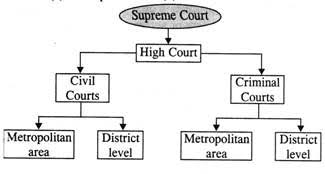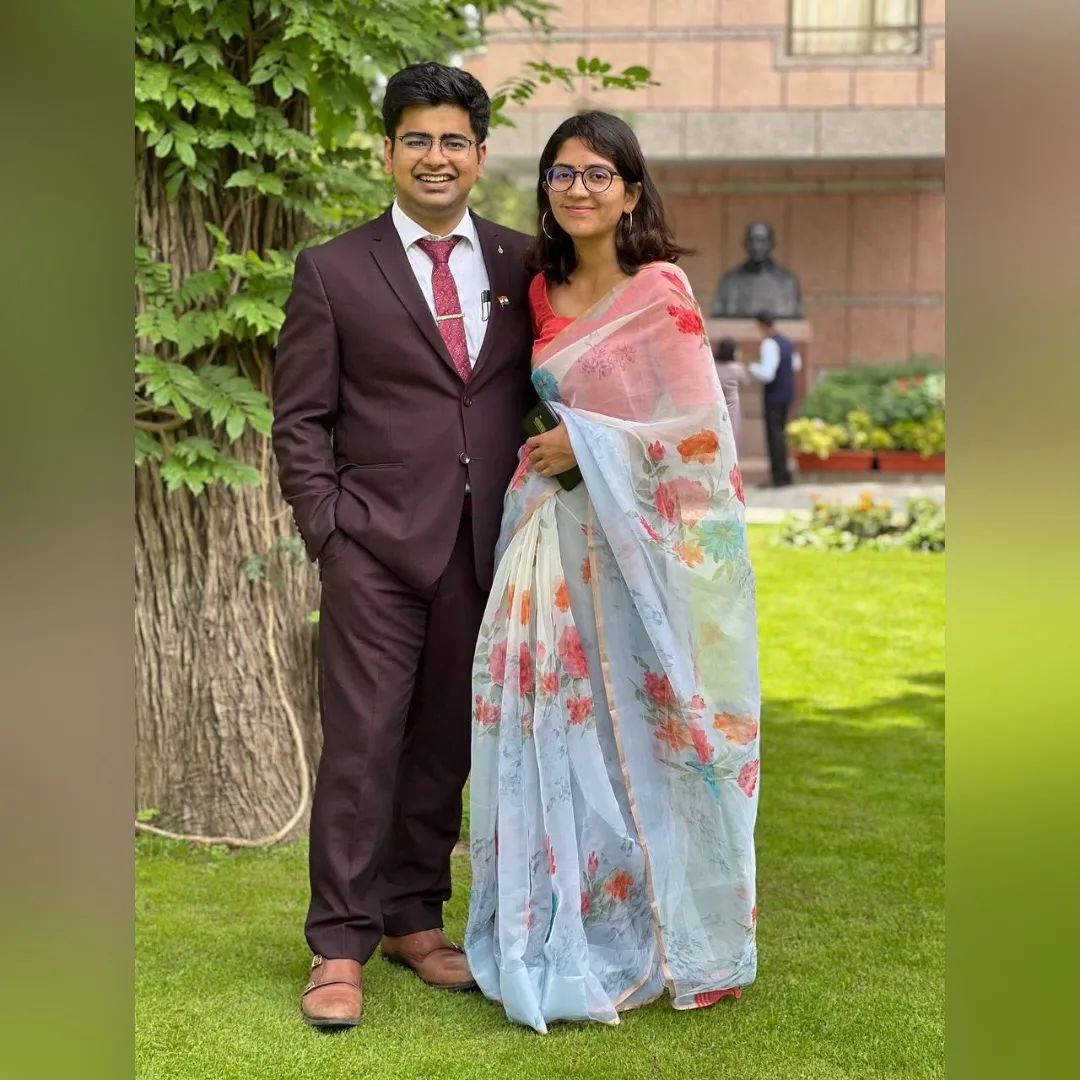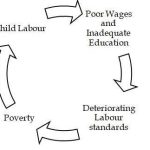
A court ADJUCATES or ADMINISTERS justice
Steps
- IT – E courts, Video Recording ( no audio though)
- All India Judicial Service
- LIMBS – to monitor govt litigation in the court
- Nari Adalat ( Guj – for women, of women), Lok Adalat, Gram Nyayalaya
- Fast track courts, Commercial division , Arbitration and councillation , Tribunals, Quasi Judicial , Arbitration – GIFT City
- National Mission for Judicial Reforms
Problem
- Delays in courts
- Over 3 crore cases pending in total
- According to an estimate, pending cases will require 10 years to solve
- In some courts ( Patna) average time per case in as low as 2 min
- Why ?
- Shortage – 40% of judges in HC, Management system, Tech, 3F, NJAC clarity , Investigation shoddy, PIL, Role of NGOs
- SC said, Fair and Speedy Trial is a part of Article 21 – Right to Life and Liberty
- Understaffed
- 400 vacancies in HC out of sanctioned strenth of 1200 judges
- Aggrevation more after judiciary-executive clash
- Suggestion for SEC
- Search Cum Evaluation Committee – Suggest in NJAC issue
- Dedicated member of experts
- Who would take over the logistical aspects – management – of searching the prospective judges, doing their background check and then bring the name to the collegium
- Will work in cooperation with the collegium
- Makes the selection process transparent, faster and objective
- Conviction rates of crimes is one of the lowest in the world – Home minister
- Expensive
- Access to justice survey found out that legal system is too expensive for most
- Only 3 % people made use of free legal aid service
- Pro Bono Legal Service
- Voluntary legal aid by Lawyers
- Promotes institute like Khap Panchayat and Crime Reporting low
- Judicial Over activism / Overreach
- Tools –
- 142, 136, 129 , Writs, PILs
- When the judiciary steps into the shoes of legislature, generally with a view to enable justice to be actually implemented
- Judicial overereach is an extreme case of activism, when not only judiciary oversteps its original mandate but also takes a decision which can be termed as Arbitary
- Judicial Overreach Example –
- Punjab HC designating that the post of Chairman of Protection of Child Rights be reserved for a HC Judge in contravention of the original provisions
- SC later termed it as abuse of power and Judicial Overreach
- Appointing the Lokayukta in UP
- Punjab HC designating that the post of Chairman of Protection of Child Rights be reserved for a HC Judge in contravention of the original provisions
- Judicial Activism Example
- Vishakha
- MDM
- Vineet Narayan case
- Hussaina Khatoon case
- Pro / Con
- Same as PIL
- Here focus more on Checks and Balances and Separation of Power though
- Way Out
- 142 be used only by a bech of more than 5 judges to reduce Discretion
- White paper to study the impact
- Restraint
- Conclusion
- SC observation
- Judges should order in consonance of law
- Should not peddle individual notions of justice
- Acting even as “candle of hope” might do more harm than good
- SC observation
- Tools –
- PIL
- no locus standi – Justice Bhagwati
- Benefit
- Aimed to provide benefits to those who can’t normally access justice
- Hussaina Khatoon Case – Release of 40k prisoners in Bihar who had served theor sentence ,
- Social, Political, Legal changes
- Vishakha Guidelines Environment protection
- CBI enquiry against officials in Vineet Narain case – independence of CBI and according of statutory status to the CVC
- Increases public confidence in judiciary
- Promotes rule of law, transparency, excecutive accountabolity , social development , Public Participation
- Aimed to provide benefits to those who can’t normally access justice
- Con
- Diversion – 3 crore cases pending. 70 cases per judge per day
- Judicial over activism – SC noted judges should not pass their own wisdom – but focus o law – Separation of Power
- SC observed- NGOs – proxy litigants to settle corporate cases
- Proxy Interest Litigations
- Harass public officials
- Genuine PILs miss out
- PIL to callback Indian cricket team
- Lawyers use for self gratification
- SC guidelines to prevent misuse
- Bona fide need
- Can’t be used against individual
- Only 5 matters where PIL can be filed
- Way out
- Code for compulsory cost
- Screening mechanism
- Expansion of right to life
- Substantive Due process vs Procedural due process
- In US, substantive due process- That is judiciary checks the arbitariness of law
- Britain – no check on Paliament
- In India
- Intended to be procedural- That is a law can be struck not because of its arbitariness but because it violates certain section of the constitution
- Since Maneka Gandhi case, SC interpretation – due process
- Although, in Rajbala case, the SC refused to upturn the Haryana’s law for minimum qualification for panchayat election – can’t question the arbitariness of the law
- See Contempt of Court
- Where
- Disobeying , Scandalising , Obstructing , Interfering
- Recently – Against Markandey Katju – a Former Judge
- Act
- Contempt of Court Act , 1971
- Article 129
- Article 19(2)
- Issues
- Freedom – 19(1) (a)
- Overuse, Abuse, Discretion, stiffling media, may be used against other judges ( Katju )
- Way Out
- Amenments in Contempt of Court Act, 1971 to objectify the various conditions
- Minimise use as in UK
- Contempt of Court proceedings be judged by a Bench of at least 5 judges to reduce discretion
- Similarly , Larger Benches can be a solution against Judicial Overreach
- Expands PoV, checks against misuse of power, leads to more stability in judgement as they are difficult to overturn
- In significant cases like Naz foundation case – 2 judge bench decided
- Relavant law – Article 145 (3) – minimum 5 judges bech for a constitutional case
- Conclusion
- IN the Hindustan Times case, the judiciary itself has called for restraint in its use and must be duly followed
- Where
- AT same time Inquisitorial Judicial System needed in some instances
- Where Judge plays an enquiring / examining role taking a Pro Active Approach
- In countries like Scotland, Japan
- Particularly where victims are traumatised – eg Rape cases, POCSO cases
- Technology starved
- Only 4 courts in India support e- case filling function
- Shows limited success of 1500 crore e-court project
- Role of Tech – When computers introduced, subastantially reduced the pendancy of no of cases
- Transparency
- NJAC annulled
- CJI under corruption charges
- RTI – Judiciary limited out in spite of decision by CIC
- Lack of Synergy between Judges
- CJI
- Master of Role issue
- Justice Chelameshwar dissent on NJAC
- Justice Karnan case
- Good line
- We have moved from Rule of Law to Rule of Judiciary to rule of Individual Judges over the years
- CJI
- Neglects the role of victim
- Economic costs of petitions
- Ease of Enforcing Contracts
- India ranks in 180s
- Access to Justice Survey report by NGO Daksh
- Loss at 0.5% of GDP due to delays and costs to go to Judiciary again and again
- Ease of Enforcing Contracts
- Solution
- Accountability
- NITI – Judicial Performance Index
- Would raise accountability
- And iduce benefits out of Competition
- RTI
- Lokpal
- Judicial Standards and Accountability Bill, 2012
- Ethics Commissioner – As in Austrailia
- National Judicial Oversights committee
- Currently – NO JUDGE has been ever impeached under ARTICLE 124(4) of the constitiution and issues like Justice KARNAN’s case are rising – Points the need for greater recourse to Article 124(4)
- NITI – Judicial Performance Index
- More judges appointment
- 35% vacancy in all HCs . 400/ 1200
- India has 12 judges per million; US has 50
- Problem not merely of govt vs judiciary
- Even in Trial courts 25% vacancy of judges
- This is completely managed by Judiciary right from taking the exam
- Points to intrinsic structural problem
- Fast Trak Courts
- Their fundings have been reduced by the central govt – States do it now
- 60% of them have been closed
- Strong need
- AIS on the lines of Civil Services
- Appoint Retired Judges as Ad- Hoc Judges
- Minimum tenure of CJI
- Management
- Of 3 crore pendency, many cases are actually closed with litigants dead or not interested
- Management requirement to settle these
- Similarly, management via Judicial Administrators would manage the logistics properly and remove the pressure on judges
- Standardisation across courts
- Like same Abbreviations
- National Mission for Justice Delivery and judicial reforms recommendations be swifty incorporated
- Looking at Business process Re-engineering, capacity development
- Technology
- Digital records – MIS
- Video conferencing to investigate & question witness
- Technological Improvements required in Criminal Investigation like Polygraph
- Artificial Intelligence in Crime solving
- Willpower– In 1990s efforts by former CJI MN Venkatchaliah resulted in reduction of pending cases from 5 lakhs to 16k cases – aided by tech
- Right ow e-courts projects lagging behind arguably due to vested interests
- Leave
- As in the case of Commercial Courts or NGT
- As a former CJI proposed, leaves on Saturday, Sunday should be removed. Instead, it could be used after the completion of a chunk of cases
- 50 days summer vaccation should be shortened
- SC has created history this year – 3 benches will be continuously sitting during the summer vacation
- Counter – Judges hearing 70 cases a day, need for refreshing
- Reduction in Govt litigations
- Currently about 50%
- Steps Taken
- LIMBS
- National Litigation Policy, 2010
- Need for more Tech like Data Analytics, Management system
- Inter department clashes should be sorted out at govt level
- Previously National Litigation Policy in 2010, but did not succeed because about ambiguity regarding petitions itslelf and empowered committees role
- NGOs
- Code for Compulsory Costs
- Screening mechanisms to filter out Spurious cases
- Alternative Judical Institutions
- Pro Bono Legal Service
- Voluntary legal aid by Lawyers
- Pro Bono Legal Service
- PLEA BARGAINING
- Takes out cases punishable upto 7 years for negotiated settlement without trial
- Adopted in 2003 under the CrPC
- However, resistance from Bar and Bench meant that it remains a dead letter
- More lok adalat, Nari Adalat,
- Tribunals –
- because they are more specialized
- and time limit can be imposed on them
- Involve the Victim more
- Committee on reforms for Criminal Justice
- Invoke greater rights on victim to participate in proceedings, hire advocates, Track Progress of Case , Right to seek compensation asdasd
- Need for Inquisitional Judicial System to comfort the Victim
- Committee on reforms for Criminal Justice
- Reform of police processes
- Like processes of investigation,
- Judges accountable
- Constitutional provision to check corruption – impeachment
- Has never been ever used
- In spite of serious corruption charges against many
- Case Study – Justice KARNAN
- Steps to increase liability of judges
- Judicial Standards and Accountability Bill, 2012
- Mechanism for investigating allegations of misbehaviour by judges
- Also provisions like declaring assets, Oversight committee ( having executive )
- National Judicial council will see administration of this law
- Only for judges of SC & HC
- Has lapsed – need to revamp this
- #Judicial accountability # Over activism # NJAC # Corruption
- Lokpal
- Collegium system –
- transparency
- Search committee
- Role of govt and IB in recommendations
- Minutes of Meeting
- RTI
- Many courts still not covered ybder it
- Information provided under it is limited, stiffled under the name of Independence of Judiciary and credibility of judges and judicial system
- Need for rationalisation
- Benefits – accountability, corruption, Appointment procedure, discrimination ( Karnan), Equality, Faith of people
- Con – Dignity, CIC over it – Independence , Information may lead to populism – Hurting court decisions, Other issues of RTI – trivial, Blackmail
- Way Out
- Judicial Standards and Accountability Bill, 2012
- Constitutional provision to check corruption – impeachment
Joint Investigation ny CJI and CIC to induce transparency while maintaining independence of Authority
- Nyaya Mitra – By ex- judges, ex- IAS officers – Need for Judiciary to actively coordinate with Nyaya Mitras
- Will listen to complaints about judges and take it forward with Judiciary
- No power to enforce
- But still an institutional mechanism
- Some states in US have a review commission for judges comprising of other judges, bar, govt, people which reviews the performance of judges in a non partisan basis
- New York and Alaska have a system of evaluation by trained court observers who make unscheduled court visits. Judges are evaluated on their knowledge of law, integrity, communication skills, sentencing, impartiality
Why NJAC / MoP ? – ARTICLE 124 ( same as impeachment )
- Separaton pf Powers not eroded by overlap
- Article 142- Court enforcing its own decision – Executive
- Article 145- SC can make rules for regulating practises and proedure of court as long as does not violate laws of the land
- Primacy of Judiciary – Because Govt makes up for 50% of the total litigations in the court
- Extra constitutional
- Constitution – President shall consult as he deems necessary for the purpose
- No accountability
- In the collegium system
- Justice Chelameshwar criticising lack of transparency in collegium
- SC recent criticism about Judicial Over Activism
- Public
- Should have a say in appointment
- All 3 limbs of govt source power from the people
- Constitution also from the people
- Various expert committees have recommended executive’s role from 2nd ARC to Law Commission
- Other countries
- UK has similar system as proposed by NJAC
- US- judges nominated by president with approval from Senate then
- Germany has election system – half votes from judiciary, half from legislature
Counter observations by Bench
- To wholly eliminate executive’s role would be counter to constitutional principles
- Hence, MoP in consultation with executive for
- Transparency in selection criteria and eligibility of judges
Conclusion:
it appears that a review of the verdict by a larger bench is necessary.
The SC though ruled that a Memorandum of Procedure will be established by the centre in consultation with the SC for reforming the collegium
- Yet controversy has risen again, with SC rejecting centres suggestions
- AG to be a part of the collegium
- Centre can reject collegium choices n the grounds of national security
- Name of judges for consideration by collegium can be suggested by
- All judges of the bench
- Bar
- AG
- List will 1st be screened by a committee of 2 retired judges and an emminent person
Reforming Collegium Sysytem
- Court agreed that reform is needed in collegium to increase transparency and accountability
- Way out
- Publish minutes of meeting of collegium online
- Committee for shortlisting
- Let a committee of ex-judges select make a list of shortlisted candidates
- The list be put online
- The public and the govt be invited to raise objections about the candidates
- Let the committee mentioned above take a decision about it
- Collegium expansion
- Expand the collegium to include a third of judges of the HC/SC
- Roughly 20 judges
- Currently only 3-4 judges form form a part
- The judges can be selected on rotation
- Expand the collegium to include a third of judges of the HC/SC
- Law ministry intervention
- Currently, govt can reject the recommendation of the collegium once
- But, if the collegium reiterates, the govt is bound to agree
- Need now is for both sides to bring in public reasons for disagreement and reasons for support
- Proposal – Expand Bench hearing a substantial constitutional amendment plea to a minimum of 13 judges
- Constitution prescribes a minimum of 5
- But was done when only 7 judges in SC
- RECENT steps
- Miniutes of Meeting to be published
- Reasons for rejection to be published
- SC – Higher courts can’t issue a mandamus on lower courts to pass a particular order. Even lower courts are covered under the doctrine of separation of power
- SC accepts 40% of all cases pending – does not bode wel for a constitutional court
National Court of Appeal
Final court of justice in hearing appeals from High Courts
Pros
- Allow SC to focus on Constitutional Cases
- Decline of constitutional benches (having 5 or more judge )
- Declined from 15% during 1950s to 0.1% now
- Quality wise
- Article 145 mandates a minimum of 5 judges for deciding any substantial case of constitutional law
- Yet, major case like Shreya Singhal, Koushal case (377) done with 2 judges
- Decline of constitutional benches (having 5 or more judge )
- The specialisde nature Would reduce pendency
- 60k odd pending cases arising out of appeals against HCs in SC NCA would ease the burden of top court
- Geographical spread
- NCA with 4 regional benches would reduce the time and cost borne by litigants in filing cases of appeals. – Daksha – Costs of litigations of 0.5% of GDP
- This will improve accessibility to judiciary.
- Hasa been recommended by the Law Commissions in the past and in the Vasanthkumar Case , SC showed Openness to the idea
Cons
- A National Court of Appeal would require an amendment in Article 130 of the Constitution of India which may be inconsistent with Basic Structure doctrine
- Short term costs such as recruiting new judges (already facing shortage), new infrastructure
- SC may still invoke Special Leave Petitions ( Article 136) to hear the appeal cases
- Will lead to duplication of efforts
Progress
- Initial SC against the idea
- But has now accepted to hear the litigation
UNDERTRIALS
- Need to have national undertrial registry
- Govt in process
- Under-trial is a prisoner, accused of committing a crime, but yet to be ‘convicted’.
- There are 2.5 lakh under-trial prisoners in India. They make up 66% of prison population in India (as of 2013)
- Has led to Overcrowding of Prisons ( NCRB – 120 %)
- Reasons for high number of under-trials:
- Trial goes on for years, conviction rate is dismal.
- Poor ‘accused’ can’t pay bail bond or hire good lawyers.
- poor & illiterate unaware about the legal provisions of bails and bonds
- High number of arrests. – Joginder Kumar case
- Hussaina Khatun case – Released 30k undertrials
- 2005: CrPC ( Criminal Procedure Code) amended with New section 436A. Under-trial person must be released, IF he has spent 50% of the maximum period for the crime, if he was convicted.
- But still, CrPC provisions are not fully implemented.
- Supreme Court’s clear holding in the Narsimhulu case that bail is the rule and jail is the exception,
- Therefore, SC ordered following (in 2014, September)
- Untertrial review committee to be set up in each district comprising of DM, SP & District Judge
- Free all the undertrials IF they’ve spent half the sentence, except cases where highest penalty is death.
- Ordered the judicial officers to begin survey of under-trials in jails- from October 1st, 2014, and file report to their respective high courts.
- Then Judge can free the under-trial on his personal bond with or without sureties.
- More steps required
- Proper work by NALSA to educate the undertrials
- Role of NHRC
- Performance of police stations should be judged on the basis of cases registered and prosecuted rather than on the basis of case registered
- Also see Vision 365 Mains 2 Page 29
- Focus on Overcrowding (120%- NCRB ) , Health, focus on RETRIBUTION rather than reform , e- Police , NHRC , D K Basu Guidelines, JS Verma Committee – CCTV cameras in Police stations and Jails
- Case Studies – Parivartan program of AP – Focus on Reform – Rave reviews
Death sentence
Situation
- 140 out of the 193 UN countries have abolished death penalty
- UN call for a moratorium on death sentence
- India’s case
- India sovereign to decide
- Death penalth awarded only in the rarest of rarest case and after consideration of Mitigating Circumstances
- Bachan Singh vs Govt of Punjab case , 1980
- Yet, every year around 2000 death penalty in lower courts
- Although, only 5% of them approved by the HC
- Shows insensitivity and misuse by the lower court
- Mitigating circumstances
- Circumstances that lead up to the crime. t does not justify the crime but may reduce the severity of it
- Law comission has recommmended banning death penalth except for terrorism related cases
- Shatrughan Chauhan vs union of India case, SC laid down the rights of the inmates on death sentence
- Delays in pardon/commutation ( article 78) amount to torture
- No threshold provided
- But the cases involved 10-15 years
- Article 21 still valid even at the death bed
- Crime under question is irrelevant
- Reverses Bhullar judgement (2013) which said that delay argument can’t be invoked in anti-terror laws
- Delays in pardon/commutation ( article 78) amount to torture
- SC observation – It is not upto the judiciary to decide Pardon . Should only oversee that fundamental rights of prisoner are not being violated – No judicial over activism
- Cons
- No conclusive evidence to show death penalth is a deterrent
- No way for course correction – SC has acknowledged in 2009, that it has erred in awarding death penalty in past
- Study by National Law University – 75% of death convicts come from poor class, caste or religion- can’t afford as the rich.
- Given that relief comes at very late stage- can’t afford to pursue till the very end
- Also may show institutional prejudice
- Relations
- Abu Salem – Portugal
- UN – moratorium
- Terrorists
- Giving them death penalty makes them martyrs, in the eyes of radical muslims
- Large crowd thronged in Yakub Menon’s funeral
- Similar with Afzal Guru
- They have ben forced to believe about the pleasures in their after life in heaven
- Life imprisonment, denies them this benefit
- In 1973, Britain decided not to impose death penalty on the IRA terrorists arguing that death penalty further incited violence, and made criminals cult figures
- Ethics- An eye for an eye makes the whole world blind
- Role of Criminal Judicial System is more to Reform than to Punish and abuse authority
- Pro
- 5% fall in crime against women in 2015 vs 2014. After death penalty led stringent law
DIFFERCNCE between selection of Judges India, US
1) In both the countries, President appoints the judges. But, in India, President is being adviced by the Collegium of judges headed by the Chief Justice of India, whereas in the USA, President nominates judges, and with the advice and consent of the Senate, he/she appoints judges.
2) Alike USA, every judge in India is to be appointed by the President under his seal and warrant. But, usually the Collegium system administers the appointments and transfers of the higher judiciary like Supreme Court and High Court, and the judges to lower courts and District courts would be recruited through examination conducted by the High Court of the State concerned. Whereas in the USA, procedure of appointment of judges to higher as well as lower courts are same.
3) In the USA, in case of vacancy, the list of nomination would be prepared after a detailed inquiry and analysis of the conduct of judges by the State departments like Department of Justice, Committee on Judiciary, and agencies like FBI, whereas in India, judges will be selected by the Collegium system in a highly opaque manner.
4) There is strong checks and balances in the USA, as nominated judges are selected for appointment based on voting in the Senate, whereas in India, there is no kind of Legislative interference in the appointment of the Judges.
Lawyers hooliganism
- R K Anand case
- Judges can debar lawyers who collect money in the name of judges and those who attend court proceedings intoxicated
- Action against lawyers who abuse judges
- Based on this TN HC issued a notification
- Helps in reducing pendency, reduced hooliganism
- Con – can also punish a lawyer who complains about a judge to guys superior without proof
Alternate DISPUTE REDRESSAL MECHANISMS
- Using tools like Mediation, Arbitration and Conciliation
- SriKrishna Committee recommendations
- Specialist Arbitration benches
- Arbitration Promotion Council of India be set up to grade Abbitral Institutes
- Govt should look for Arbitration under National Litigation Policy, 2010
- SriKrishna Committee recommendations
- Indian Culture – Panchayat
- Finds its basis in the Article 21 -SC Right to Fair and Speedy Trial
- Article 39A
Committee on reforms of Criminal Justice in India
A suggestion under this could be dividing the penal code into four different codes: Social Offences Code,
Correctional Offences Code, Economic Offences Code and Indian Penal Code.
ü The Social Code includes matters of civil nature that can be settled without police intervention and
prison terms through administrative processes.
ü The Correctional Code includes offence punishable up to three years imprisonment where pleabargaining can be liberally invoked.
ü Economic Code includes property offences, which affect financial stability of the country dealt with
through combination of criminal and administrative strategies.
ü Indian Penal Code will include only major crimes warranting ten years imprisonment or more or death
Plea Bargaining – Written above
- Lok Adalats
- Positive
- 6 Lakh cases were resolved using it
- Was part of Indian judicial system before British
- Even now – Khap – But not right
- Benefit – No advocate , cheaper (free), govt costs associated with procedural rigidities also saved, faster, reduces judicial burden, focus on concilliation does not impoverish relations, Same authority as Court Decree
- Instrument of Inclusive Justice in accordance to article 39A
- Why less successful ?
- Other bodies – Khap Panchayats, Gram Nyayalalya,
- 3F
- Aura of Court
- Lack of Privacy in Lok Adalat
- Focus on consent– which is not easy to reach
- Positive
Gram Nyayalayas or village courts
- Established under the Gram Nyayalayas Act, 2008 for speedy and easy access to justice system in the rural areas of India.
- The Act came into force from 2 October 2009 but has not been enforced properly, with only 200 functional Gram Nyayalayas in the country against a target of 5000 such courts.
- The major reason behind the non-enforcement includes financial constraints, reluctance of lawyers, police and other government officials.
- Gram Nyayalaya are established generally at headquarter of every Panchayat at intermediate level
- The Gram Nyayalayas are presided over by a Nyayadhikari,
- The Court can function as a mobile court at any place
- The Gram Nyayalayas have both civil and criminal jurisdiction over the offences. The pecuniary (monetary) jurisdiction of the Nyayalayas are fixed by the respective High Courts.
- Gram Nyayalayas has been given power to accept certain evidences which would otherwise not be acceptable under Indian Evidence Act.
TELE Law initiative started to avail legal help on Telephones with the help of Pro-Bono Lawyers
Mediation/alternative Dispute Resolution in criminal cases : Rape
- The Justice J.S. Verma Committee report put the case of rape in context of gender justice. However, the recent judgment of the Madras High Court of referring a case of rape to mediation raises serious concerns on how the crime of rape is perceived by the judiciary.
- The judgement reinforces the social taboo and stereotypes regarding future of child born out of rape and seeing rape as only expression of lust.
- What is Mediation and its unsuitability in this case
- Mediation is a form of Alternative Dispute Resolution (ADR) where a neutral mediator assists the parties concerned in arriving at a mutually agreeable settlement.
- It is a mechanism that seeks to reduce the burden on the courts.
- Active role of parties in the final outcome as opposed to a decision handed down from the judiciary.
- Some degree of success in civil and matrimonial disputes, its applicability to criminal law is questionable.
- Civil disputes involve private rights of parties in dispute while a criminal offence is against the rights of the victim as well as society because whole of society has an interest in preventing crimes. It provides scope for the abdication by the state of its duty to prosecute the accused. Also rape is a non compoundable offence ad parents of victim or victim had no right to settle the case.
- Only minor criminal cases have been referred to mediation in the past.
- Consent of all parties is vital to refer a case to mediation. In the current order of the High Court, the opinion of the survivor has been completely neglected and her consent has been disregarded.
- An increasing dependence on ADR dilutes the authority of the court.
- During mediation, parties should be aloof from any unbalanced coercion. One implicit coercion in this case is regarding the future of victim and child.
- Any liberal approach in case of rape is against the dignity and honour of women according to SC
- What should be done?
- Adequate support for the victim to overcome trauma is what is needed
- Previous judgements have highlighted the importance of giving an opportunity to survivor to be heard. This can be done by ensuring that a special public prosecutor is appointed if the case warrants so; to ensure that the survivor is represented through a counsel at all stages of the process and to ensure that there is witness protection.
NALSA
- National Legal Services Authority of India
- Headed by CJI
- Provides free legal aid to women, children , poor, SC, ST, members in custody, etc
- Based on 39A of the constitution
Commercial Division and Commercial Appellate Division of High Courts and Commercial Courts Bill 2015
- The Bill enables the creation of commercial divisions in high courts, and commercial courts in every district
- commercial disputes involving an amount of Rs one crore or more.
- Commercial appellate divisions: Commercial appellate divisions may be set up in all high courts to hear appeal
- Time period for filing appeals: Such appeals to the commercial appellate division must be made within a period of 60 days of the order of the lower court.
- Transfer of pending suits: All suits of a value of Rs one crore or more
- Benefits
- Ease of Doing Business – Ease of Enforcing contracts
- Dakshsa – Costs to GDP of 0.5% , increased competitiveness
- Financial capital
- BIT- FDI issue
- Augments exising capability , Tradicial judiciary can be mainstreamed for 3 crore pending litigations
- Cons
- Commercial definition – very wide – ma be misused for other civil cases as well
- SR costs associated with transfer of cases
- Act does not include new technologies – Old bottle in new wine
- Conflict with regular courts
ELECTRONIC
The Union Cabinet chaired by the Prime Minister recently gave its approval for the second phase of eCourts Mission Mode Project at an estimated cost of Rs.1670 crore.
◾It envisages enhanced ICT enablement of courts through universal computerisation, use of cloud computing, digitization of case records and enhanced availability of e-services through e-filing, e-payment gateways and mobile applications etc.
Background:
◾The eCourts project of the Government is aimed at providing necessary hardware and software applications to enable courts to deliver e-services to citizens, and to enable the judiciary to better monitor and manage the functioning of courts.
◾In Phase I of the project more than 13000 District and Subordinate courts have been computerised and case information linked to the respective District court websites.
◾These courts are now providing online eServices such as cause lists, case status and judgments, to litigants and public through the eCourts portal.
◾Litigants and lawyers are also provided services through Judicial Service Centre at the court complexes. More than 24 crore transactions have already been recorded regarding online access of court information.
Phase 2:
◾The Phase II of the eCourts project would also help in the automation of workflow management in courts thereby contributing to better court and case management.
◾Touch screen based Kiosks and Video Conferencing facility will be installed at all Court Complexes and corresponding jails.
◾Hand held process service devices will be provided to process servers to ensure transparent and time bound delivery of court notices and summons. Also, the use of solar energy has been proposed at 5 percent of the court complexes on a pilot basis.
- Curative Petition
- A 2nd layer of review, after the initial review
- Evolved by SC in 2002 in Hurra judgement
- Why needed
- If it is proven t that judge reviwing may have underlying biases
- The aggrieved person has not been heard
- If petioner establishes that there is violation of Natural Justice
- To ensure that Curative petitions are rare rather than regular
- They are first heard by a bench of 3 senior most judges along with the ones who presided over the review petition
- Then majority votes
- Used in Yakub Menon case, Naz foundation (section 377)





![UPSC CSE Topper Mains Answer [Part 2] images-2023-06-17T192027.770](https://iasbio.com/wp-content/uploads/2023/06/images-2023-06-17T192027.770-150x150.jpeg)









